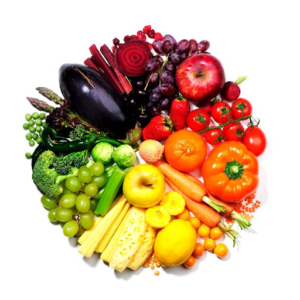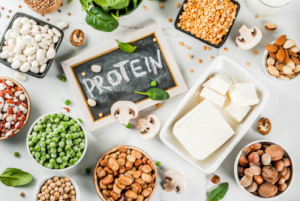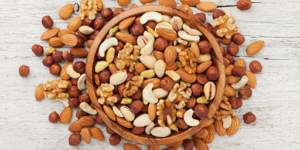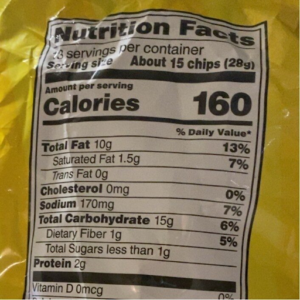Written By: Jennifer Bechard
Edited By: Ravjyot Ughra
Designed By: Sandra
Published By: Maryam Khan
Have you ever gotten to the bottom of a bag of chips, only to realize that you’re still not satisfied? Ever felt hungry minutes after eating a snack? While hunger is not necessarily a bad thing (it tells us when our bodies need more food which is super important!) it can be tiring and frustrating to eat, eat, eat, and still want more. In order to feel satisfied from our snacks so that we can get our minds off of “hungry mode”, there are some general guidelines that can help you maximize fullness and satisfaction from what you choose to eat. In this article, I’ll provide some insight and tips on how satisfaction from eating actually works, and suggest some ways that this can be maximized.

Instead of viewing snacks as extras that we consume “on top” of meals, we can instead conceptualize them as small meals in themselves that help us stay energized throughout the day. However, there are some basic principles we should strive to follow in snacking in order to maximize the amount of “fuel” we have in our tanks. I’ll be explaining the three macronutrients that we should think about while building a snack, as well as some convenient, snack-able examples of each nutrient. Lastly, I’ll explain how to pair these foods together to make an ultra-satisfying and ultra-yummy snack.
Firstly, a quick introduction into the three major macronutrients (nutrients that must be consumed in large amounts): fat, fiber-rich carbohydrates, and protein.
Dietary fats come in many varieties. For now, we’ll keep it simple and talk about all fats as a whole. Fats are a high source of slow-digesting energy, meaning that they’ll keep us full for a long time.
Fiber-rich carbohydrates (shortened as carbs) are contrasted with processed carbs. Fiber binds carbohydrates together and cannot be digested by the body, leading to slow digestion (meaning longer fullness). Processed carbs, such as white bread/pasta and refined sugar, have been stripped of their fiber, and consequently, are digested very quickly; that’s why we get very hungry shortly after eating a sugary snack.
Protein, as you probably know, is the muscle-macro. Essential for muscle repair, protein is also vital when it comes to satiety; it is the macronutrient which is digested slowest, meaning that getting a good dose of protein in each snack is essential to sustain you until your next meal.
Now that you’re acquainted with the three macros, I’ll provide a brief list of some convenient and snackable sources of each:
Sources of fiber-rich carbohydrates
Fresh fruits and berries 
Leafy green vegetables (broccoli, spinach, kale)
Starchy vegetables (potatoes, sweet potatoes, corn, etc.)
Root vegetables (beets, carrots and baby carrots)
Whole grain bread
Whole grain crackers
Pretzels
Popcorn
Sources of Protein 
Protein bars
Meat jerky
Trail mix, seeds, nuts
Roasted chickpeas
Dried edamame
Eggs
Greek yogurt
Hummus
Legumes (beans, chickpeas, lentils)
Tofu and other soy products
Sources of fat 
Nuts (almonds, cashews, walnuts etc.) and peanuts
Nut butters (peanut butter, almond butter)
Seeds (pumpkin seeds, sunflower seeds, etc.)
Full-fat yogurt
Cheese
Avocados
Dark chocolate
Eggs
Granola
When building a snack, try to incorporate a source of each nutrient. For example, greek yogurt topped with granola and berries is a super satisfying, super tasty combo!
You’ll notice that some items are listed under multiple categories (such as nuts and eggs). Such foods contain a good dose of healthy fats and protein, meaning that when paired with a carb, like a piece of fruit, for example, they can make an easy, portable, and filling snack.
Mixing and matching is the spice of life when snacking, try out different combos and see what you can come up with! The above list is certainly not exhaustive, every food has a unique nutritional profile that, with a little nutritional education, you will be able to turn from an ‘okay’ snack into a super satisfying, hunger-crushing combo.
 For example, craving some potato chips? A look at a Lay’s potato chip nutritional label tells us that they’re mainly composed of carbs and fat. So, to make this a more satisfying snack, we can serve the chips with some protein-rich nuts or trail mix in order to balance it out (and stop us from eating half the bag before feeling full!).
For example, craving some potato chips? A look at a Lay’s potato chip nutritional label tells us that they’re mainly composed of carbs and fat. So, to make this a more satisfying snack, we can serve the chips with some protein-rich nuts or trail mix in order to balance it out (and stop us from eating half the bag before feeling full!).
As you can see, a little nutritional literacy can go a long way. Upon first glance, nutritional labels may seem like an intimidating jumble of numbers. While it can be easy to get caught up in the specifics, I think keeping it simple is the way to go. When deciding which snack foods to pair together, I don’t concentrate on the numbers. Instead, I just generally classify a food as either a fat, fiber, or protein according to the label information, and think about what other foods I could pair with it in order to maximize balance between the three macronutrients while keeping flavour and fun in mind; emotional satisfaction is a major part of feeling satisfied after a snack.
The fat, fiber, protein method of snack-balancing allows us to eat all of the fun foods we love, restriction free, and still feel satisfied while giving our bodies the nutrients we need. Yes, this means that even Cinnamon Toast Crunch (my personal favourite “junk food”) can fit into a balanced diet (and indeed is super filling and tasty when paired with milk and some walnuts)!
At the end of the day, remember that eating what makes you feel good, physically and emotionally, is key. Balancing the foods we love with nutritious pairings maximizes satisfaction, both physically and emotionally. This method of snacking will help build sustainable, healthy eating habits that will help us feel our best!
For more information about this topic, please check out Registered Dietician Abbey Sharp’s amazing blog (link below).
https://www.abbeyskitchen.com/hunger-crushing-combo/
References
Bonnaccio, M. et al., (2020). Lifestyle and biological factors influence the relationship
between mental health and low-grade inflammation. Brain, Behavior, and
Immunity, 85(1), 254-256. doi: 10.1016/j.bbi.2019.04.041
Basturk, B., et al. (2021). Evaluation of the effect of macronutrients combination
on blood sugar levels in healthy individuals. Iranian journal of public health,
50(2), pp. 280–287. https://doi.org/10.18502/ijph.v50i2.5340
Furukawa, T., et al. (2021). Effect of the interaction between physical activity and
estimated macronutrient intake on HbA1c: population-based cross-sectional and
longitudinal studies. BMJ Open Diabetes Research and Care, 10(1), pp. 65-83,
doi: 10.1136/bmjdrc-2021-002479
Sharp, A. (2022). Hunger crushing combo snacks. Abbey’s Kitchen.
https://www.abbeyskitchen.com/hunger-crushing-combo/

